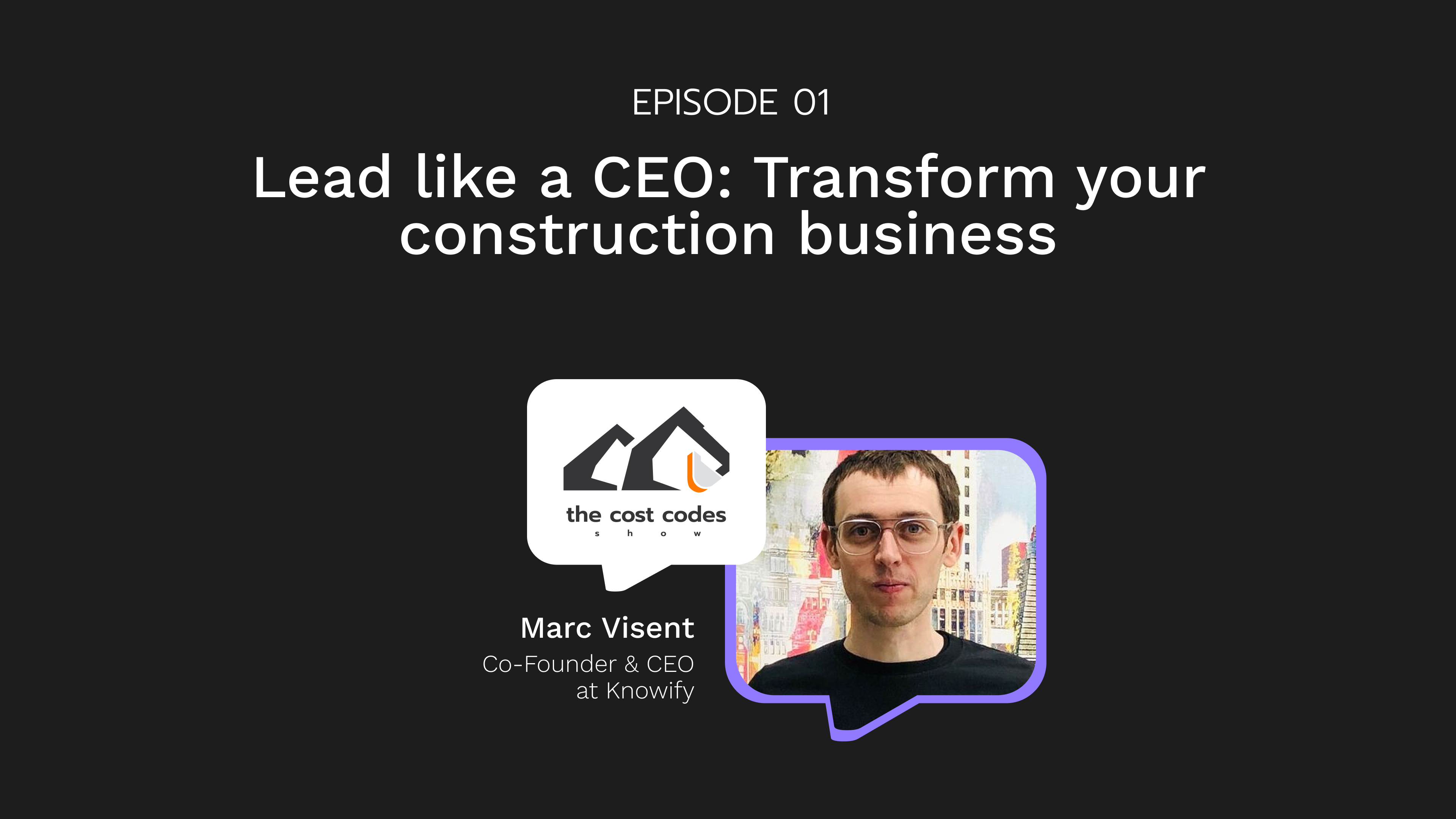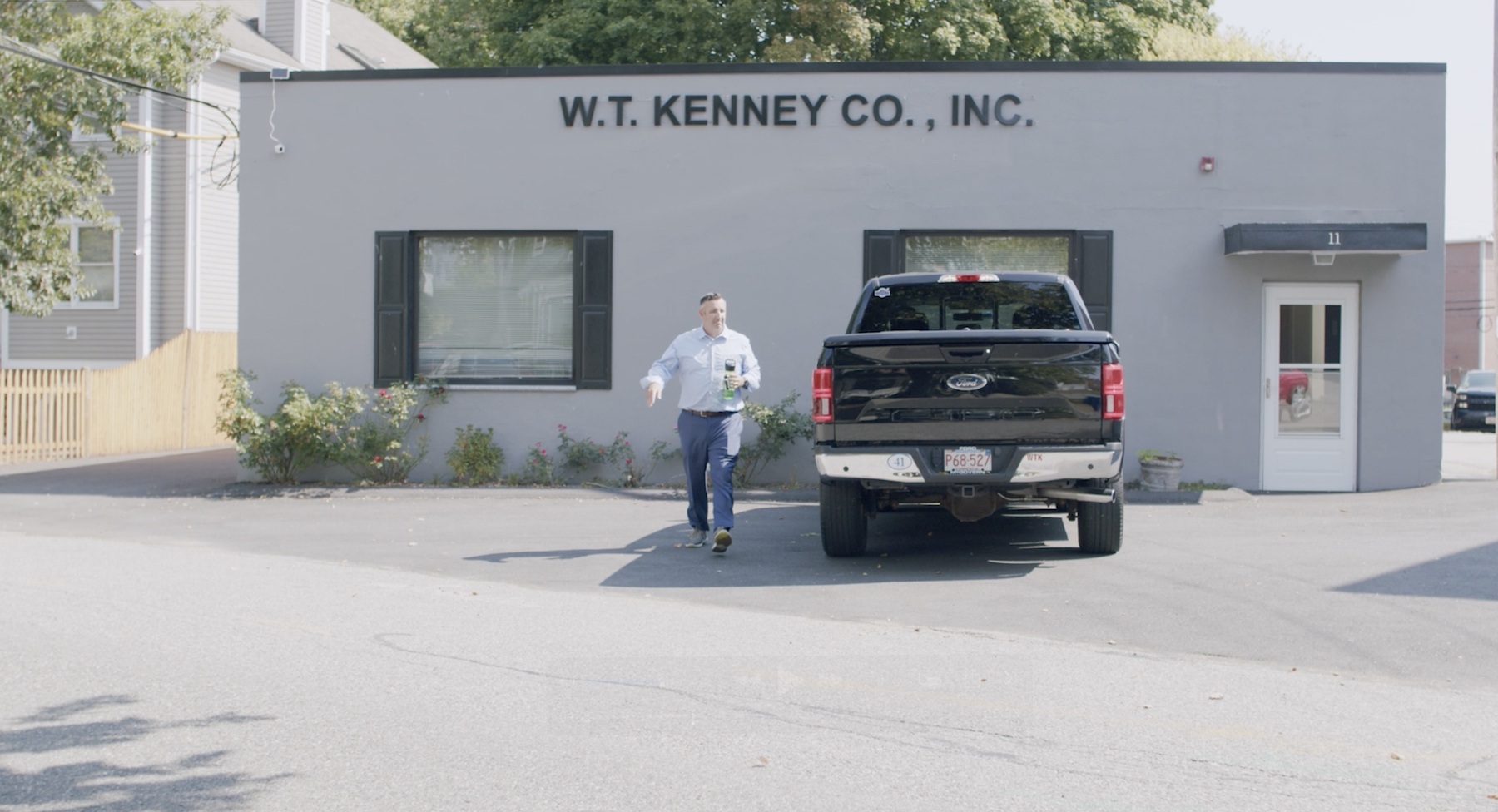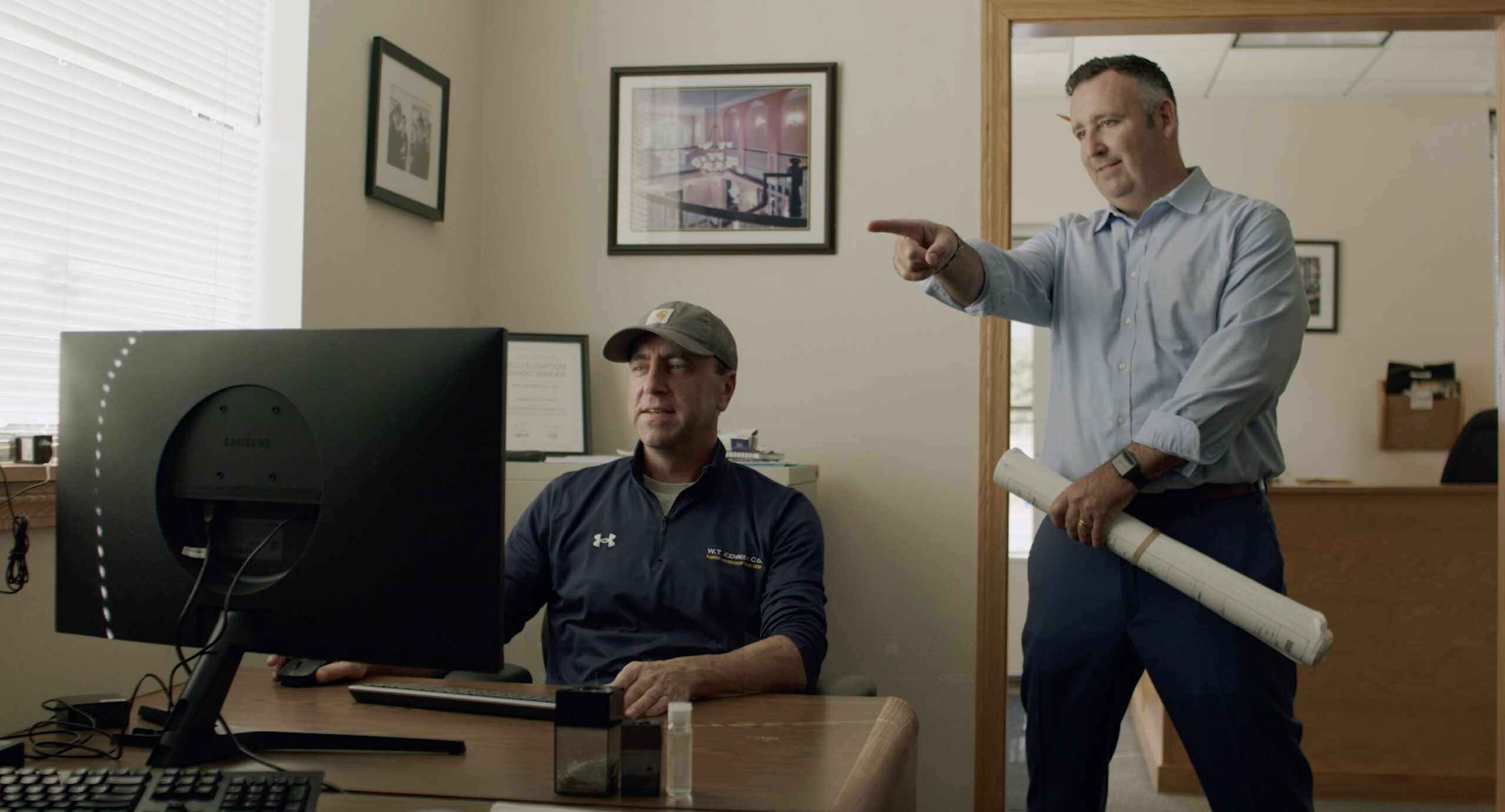Episode transcript
RYAN GILMORE:
Hello everybody. Welcome to the Cost Code Show, a new podcast from Knowify where we cut through the noise and bring you practical ideas for running a more profitable, efficient construction business. I’m your host, Ryan Gilmore. Today I am joined by Marc Visent.
Marc is the co-founder and CEO of Knowify, but that’s just scratching the surface. How are you doing today, Marc?
MARC VISENT:
Very good. How are you, Ryan?
RYAN GILMORE:
Doing well, doing well. Marc’s gonna talk to us about a few big picture topics: his evolution from his legal background to running a software company, leadership lessons he’s learned along the way from growing the company, company vision and turning strategy into daily ops, and creating accountability and transparency in the company.
Before we get started, I do wanna touch on one thing: our goal with this show is to be a little bit different from some of the podcasts you might be familiar with. It’s not gonna be an hour or two of folks waxing poetic. We wanna make it as practical and actionable as we can. So we’re gonna try to keep it short and to the point. And we’re also gonna make sure we always include a valuable resource to help you run your business more efficiently.
In today’s show notes, we’re gonna include our Contractor Assessment and Action Plan. This is a free downloadable tool. It allows you to score your business along a few different criteria—like internal processes, financial management, your use of technology—and then based on that score, we’ll make some concrete recommendations for how you can improve.
So with that out of the way, let’s get rolling. Marc, why don’t you just get started by telling us a bit about your background and how you got into the software business?
MARC VISENT:
Absolutely. So I actually started in software pretty early. As a kid, I always enjoyed coding and learning new languages. That brought me to engineering school where I specialized in computer engineering. That was during the early days of the internet and software as we know it today—so a great time to be learning and building the first products.
Then I took a long break—I went to law school and practiced law for a few years. As I was practicing law and working with big clients and corporations, I realized what I really enjoyed were all the business challenges they were trying to solve. They were trying to solve them from a legal standpoint, but there were all sorts of other issues they were facing too. I realized that, realistically, I wanted to be the client—not the lawyer.
That brought me to the US, and eventually I met Dan. We both started Knowify with the idea that running a small business is not easy. It’s full of challenges and things you always wish were better. Our idea was to create a foundation for a better business—workflows and ways of running your business that grow with you. Not just everything in your head, on paper, or in spreadsheets—but everything in one place.
RYAN GILMORE:
Nice. So jumping off of that—what were some of the early challenges that you and Dan experienced in shaping the company vision, and how did you guys overcome those?
MARC VISENT:
I think the early challenges were the challenges we all know about in the construction industry—like the hesitation around using and leveraging technology. If you think about how technology has helped the construction industry and go back in time to the beginning of the internet, productivity growth in construction has actually declined, which is crazy.
You’d think something as transformational as the internet would help, but construction didn’t leverage it the same way other industries did. So we ran into that mistrust—people not believing technology could help their business. And to be honest, part of that was on us, the software providers. Maybe we never built the right tools—tools that actually made a difference for business owners.
It was on us to prove the value and the ROI of using technology—to show that the time you spend embracing technology pays off. And in the early days, starting something new is never easy. There’s nothing out of the box. You have to change your processes. So the challenges we faced were really the challenges of the industry: can we adopt technology in a way that makes sense?
RYAN GILMORE:
Nice. And from what I understand, when you started at Knowify, you weren’t actually the CEO. You were more of an employee and then transitioned into that leadership role. I think that’s familiar for a lot of our clients—they start in the trade, grow into a foreman role, and eventually run the business. Maybe you could talk about that transition?
MARC VISENT:
Yeah. I think in my case, like you just said, it’s like the case of the foreman who grows into running the business. When I joined, the business didn’t even exist—we had no customers yet, we were just building.
It became obvious to Dan and me that I would be a good fit to lead the business based on my background in technology and business management. I come from a family of small business owners, so I had a natural connection with the challenges we were solving and how we wanted to solve them.
One of the early lessons was that someone like me, coming from somewhere else, could become the CEO. The second was the importance of partnering with the right people. In my case, working with Dan meant we could be honest with each other, evaluate our strengths and weaknesses, and decide what made the most sense for the business. That honesty helped us find the right roles for each of us.
RYAN GILMORE:
Yeah, that’s awesome. I also want to build on that because you’re talking a lot about people and personalities—finding your role in the company. Knowify has obviously grown from just the two of you to a larger team. It’s still small in the grand scheme of things, but bigger than it was. How do you approach hiring? How do you identify the right needs and the right people to meet those needs? Talent is always a challenge in construction.
MARC VISENT:
Early on, we focused on talent—and honestly, on the quality of being a good human being. It’s about finding the right balance.
Everyone talks about “leveling up talent,” but I think we often confuse two concepts: bringing in great people for your company and raw talent. Maybe part of someone’s talent is actually being a great fit for your company.
Since the early days, we’ve tried to be very intentional about hiring people who are the right fit—not just the most talented applicants, but those at the right stage in their careers, with the right mentality, and a good fit for our business stage. We’re growing, and it can be chaotic. If someone expects a job where everything’s under control, this isn’t the right place.
You’ll be asked to do things that weren’t in your job description. So we’ve always prioritized hiring the right people, sometimes even sacrificing a little extra “talent” for someone who will actually thrive with us and work well with the team.
RYAN GILMORE:
That’s awesome. And I think that leads to another important question—once you have the right people in place, how do you keep them? How do you retain talent? One of the cool things about Knowify is that there’s very little turnover. People seem really happy here. What’s the secret?
MARC VISENT:
I think, without repeating myself too much, it all starts with hiring the right people. If you do that, the odds of retaining them are much higher.
We’ve always been focused on being efficient. That’s something we try to encourage our customers to do, and we aim to lead by example. Bringing in the right people is critical because switching them out is incredibly disruptive. So we avoid that by hiring well, onboarding carefully, and setting expectations clearly.
If I told someone joining Knowify that this was going to be a quiet, chill, low-stress job—I’d be lying. The reality is that you’re going to have to do unexpected things. If you’re not okay with that, I’d be setting you up to fail. So we avoid that by being honest up front.
We also assume the best—that we hired the right person. So when something isn’t working, we first look at ourselves: Did we provide the right environment? Were the tasks clear? Were the resources sufficient? We look internally before pointing fingers.
We try to be transparent about how the company is performing—revenue, goals, whether we’re behind or ahead. We want individuals to do the same. Did we deliver what we said we would? If not, let’s figure out why and improve together. That’s our philosophy.
RYAN GILMORE:
Yeah, the focus on transparency, I think, is a big one. So maybe we could transition a little bit more to accountability and managing processes day to day. What kind of tactics do you guys implement to help maintain transparency and create alignment through all the different teams at Knowify?
MARC VISENT:
At the company level, it’s a little bit what I just described—we try to literally share how we’re doing. There’s no part that we hide or keep off-limits. Sometimes people are shocked at how transparent we are. We’ll even share how much cash we have left or how far behind we are in terms of revenue.
It’s important. If you’re trying to do your job, you need to understand how the company is doing. You can’t do your job in a vacuum—it has to connect to the overall strategy. If the company’s behind, you should probably be asking yourself what more you can do.
That’s why transparency is key. It helps people re-evaluate their day-to-day, their priorities, and their goals. If you’re in marketing and we’re behind on revenue, are your current efforts helping? Are they generating the leads we need? That transparency brings clarity.
The other side is empowering people to take control of their own goals. There’s nothing worse than being responsible for a goal you can’t control. We try to ensure that our team members own their goals. And we encourage them to set their own objectives.
In a few weeks, we’ll sit down to talk about where we want to go next year. That conversation starts with each team asking themselves, “What can we do?” It’s a bottom-up process. A lot of companies set goals top-down—we do it the other way. My job is to summarize, align, and define big themes. But the vision starts with the team.
RYAN GILMORE:
You’re talking a lot about developing a sense of vision—why that matters and how it’s helped Knowify. How can that apply to a construction business?
MARC VISENT:
Our case is a bit unique because I wasn’t a contractor. I built a tool to help contractors, but I wasn’t one myself. That forced me to listen. I had to talk to our customers and understand their pain points.
The vision has evolved, but the core has stayed the same: help people run better businesses. That can mean something different for each person. Some contractors want to grow. Others want to go home earlier. Others want to make life better for their team. Technology can help with all of that.
So our job is to build tools that help people however they define success. A few years ago, we were just building screens and features. Now, we’re asking, “Can we do the task for you?” We want to help run your business on autopilot. That’s the evolution.
RYAN GILMORE:
Let’s bring that back down to the day-to-day. For business owners trying to develop a long-term vision while also staying on top of daily operations—how can they balance that?
MARC VISENT:
First, acknowledge that the two are different but connected. Strategic vision guides your decisions, but daily operations can feel disconnected. You have to hold both.
Second, make sure your vision is clear. Without clarity, everything starts to shake. One of our early customers said, “I just want to run the business from the beach.” That was his vision. Okay—then your operations need to support that. You can’t take every job. You need repeatable workflows and reliable clients.
If you want to build a massive company, that’s a different vision. But then you can’t complain when your day-to-day is intense. That’s part of the journey. So it’s about matching your vision to your reality and making sure your actions reflect what you actually want.
RYAN GILMORE:
Let’s talk product. How has customer feedback shaped development at Knowify?
MARC VISENT:
Everybody says they listen to feedback, but we really do. Especially early on, we were very insecure about not being from the industry. So we listened obsessively.
Now, we’re more mature. We have a vision. Feedback today is filtered through that lens. Does it fit? Does it help us build the kind of platform we believe in?
Sometimes one person gives feedback that’s so good we’ll fast-track it. Other times, if it doesn’t fit the direction we’re going, we won’t implement it, even if a hundred people ask.
But when feedback is aligned, we jump on it. One early user said, “Help me avoid missing change orders. It costs me thousands.” That became a core feature. Simple, but transformational.
RYAN GILMORE:
What advice would you give to someone trying to modernize their business but facing internal resistance?
MARC VISENT:
Be transparent. Tell your team what you’re trying to achieve. A lot of software tools, like Knowify, will require changes to how you work. Don’t sugarcoat that.
I always say—you won’t hear from me that starting with Knowify is easy. I don’t know your business or your history. It might be tough. But explain why you’re doing it. Maybe it’s because you want your team to go home earlier. That’s a great reason.
You’ll still face resistance. People like consistency. You’re changing something. Some might see it as a threat. But if you lead with honesty and clarity, you’ve got a better shot at success. And if someone is actively standing in the way, sometimes you have to make tough calls.
RYAN GILMORE:
As a business leader, how do you avoid burnout?
MARC VISENT:
I used to be bad at that. I love the work, but over time I realized that loving it doesn’t make it healthy. You have to be mindful of your limits.
Find people to talk to. I’ve been lucky to have Dan, but also mentors and advisors. Running a business means you get a lot of bad news. It helps to have support.
Most importantly, pause and reflect. When everything feels chaotic, the instinct is to go faster. Usually, what you need is to stop for a second, think, and ask, “What’s really happening here?”
RYAN GILMORE:
Last question—in the spirit of keeping things actionable: what’s one thing our listeners can do this week to improve their business?
MARC VISENT:
Define your vision. If you can’t explain your business vision in one sentence, take a day to figure that out. If you still can’t find it, maybe you’re not in the right business—or maybe someone else should be leading.
Once you have that vision, set goals that help you get there. Then break those goals into small actions. But everything starts with that clarity of purpose.
RYAN GILMORE:
That’s a great note to end on. Marc, thank you for joining us.
To everyone watching and listening—thanks for tuning in. Don’t forget to check the show notes for your free Contractor Business Assessment Tool. And if you’re looking for help managing your construction business more efficiently, check out Knowify at Knowify.com. We’ll be back with another episode soon. Cheers.
 QuickBooks
PricingTraining & support
QuickBooks
PricingTraining & support



